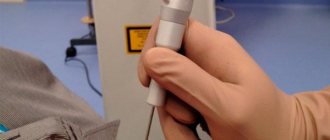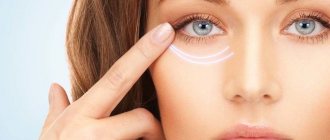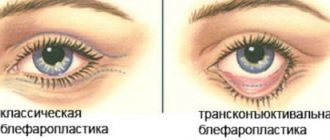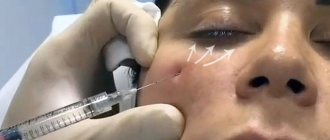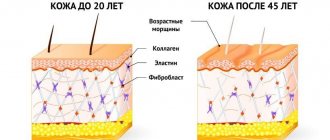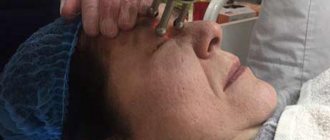Modern aesthetic medicine every year comes up with new ways to prolong youth. One of the most popular in this area is eyelid blepharoplasty. This manipulation is carried out surgically and allows you to permanently get rid of wrinkles, sagging eyelids and bags under the eyes, as well as correct the shape of the eyes, incision, etc.
Blepharoplasty can be performed not only surgically, but also non-surgically. This method is less traumatic, practically painless, has minimal contraindications and almost does not cause unwanted reactions. Read more about the “ non-surgical blepharoplasty ” procedure, its features, types, advantages and disadvantages below.
What is blepharoplasty?
The skin around the eyes is very thin and sensitive. In addition, this area contains a small amount of collagen. Therefore, this area is most often susceptible to the formation of wrinkles, which are very difficult to eliminate without the involvement of hardware or injection procedures.
Blepharoplasty can correct this situation. The procedure also has the ability to eliminate fatty deposits on the eyelids, tighten sagging skin, and get rid of bags under the eyes.
Stages of the procedure
Non-surgical eyelid surgery consists of the following stages:
- Disinfection of the eyelid area.
- Putting special lenses on the eyes to protect them from external influences.
- Carrying out hardware effects or injection procedures.
- Postoperative disinfection of the intervention area.
- Applying a cold compress to relieve swelling.
Sometimes blepharoplasty requires additional marking of the eyelid area, which is done before the actual administration of the drug. This stage ensures more accurate lifting.
Features of non-surgical blepharoplasty
Blepharoplasty, performed without surgery, can be compared to the operating room. This is an innovative and unique technology aimed at rejuvenating the dermis of the eyelids. The procedure is performed through the use of special devices and injections, which helps to dissolve the fat layer, remove excess fluid and regenerate damaged skin layers. In addition, this manipulation removes traces of fatigue, prolonged stress, and returns youth and freshness to the face.
Non-surgical blepharoplasty is as safe as possible; there is virtually no pain during its implementation, the risk of complications is minimal, and there is no long and difficult recovery period.
What problems does non-surgical blepharoplasty solve?
Non-surgical blepharoplasty has the following list of indications:
- Removes dark circles, swelling, bags and puffiness under the eyes.
- Smoothes out fine wrinkles.
- Relieves ptosis (drooping of the upper eyelid).
- Provides nutrition to dehydrated and dry skin.
- Eliminates skin cells susceptible to damage.
- Removes fat folds on the eyelids.
- Removes crow's feet.
Types of injections and drugs
To change the contour of the eyelids and smooth the skin, fillers with hyaluronic gel and preparations based on the same are used: Glytone, Stylage, Restylane, Teosyal, HAfiller, Meso Wharton P199, MesoXanthin F199.
For injection blepharoplasty of the upper eyelids and elimination of “bags” under the eyes, Dermaheal Eyebag Solution, Lipostabil and MRX-lipolytic complex are used. The preparations contain plant extracts, multivitamins, and chemical components.
The mesopreparation Dermahel Dark Circle Solution helps get rid of dark spots under the eyes.
Eyebag essence is effective for ptosis of the outer corners of the eyes and drooping eyebrows.
Many drugs effectively cope with various problems, so injections are suitable for tightening both the lower and upper eyelids.
Types of non-surgical blepharoplasty
Non-surgical blepharoplasty is performed by two methods - using injections and using devices. Let's look at each method in more detail.
Injection blepharoplasty
This method is carried out by introducing medicinal components under the skin, which smooth it and give it firmness and elasticity. Each drug used has its own purpose and type of effect.
| Purpose of injections | What is used for this: | Type of impact |
| Injections that eliminate excessive subcutaneous tissue on the eyelids. | Preparations for injection lipolysis. | These agents increase the permeability of cell membranes, which ensures an effect on the fat layer itself. These preparations are based on enzymes, fatty acids, multivitamins, and plant extracts. Unlike fillers, injectable lipolysis products are injected much deeper into the dermis to affect the fat layer. |
| Injections that smooth the skin around the eyes and change the contour of the eyelids. | Hyaluronic acid fillers, bioremediation preparations. | The active ingredients are evenly concentrated under the skin, smoothing it from the inside. Such drugs act on weakened cells, activating the synthesis of collagen fibers and elastin. |
| Injections that combat swelling and puffiness. | Lipolytic complexes, multivitamins. | Breaks down sebum in the lower eyelids. |
Let's consider the popular drugs that are used for injection blepharoplasty:
- Caregen . Mesotherapy drug of Korean origin. Created on the basis of biomimetic peptides. Presented in the form of an aqueous solution. Sterile. Used to eliminate hernias, dark circles under the eyes, swelling and pigmentation of the lower eyelids. The product contains the enzyme CG-Lipoxyn, which thickens the anterior walls of the eyelid by activating the production of hyaluronic acid, elastin and other components. Caregen does not contain lipolytics.
- Eyebag Essence . This drug contains biometric peptides. These components promote the resorption of subcutaneous tissue in the eyelids. This procedure is an excellent alternative to surgical blepharoplasty. Used for drooping corners of the upper eyelids and hernias of the lower eyelids. Dark Circle Essence can be used as an additional product. It is advisable to use the drug for dark bags under the eyes, fine wrinkles, and too thin eyelid skin.
Before and after
The duration of the injection procedure is 30 minutes. The course is about 8 manipulations. The frequency of procedures is 1 time per week.
Hardware blepharoplasty
These types of hardware blepharoplasty are considered the most effective and frequently used.
- Laser.
- Ultrasonic.
- Thermage.
- Thermolifting.
- Raylife.
- DROT therapy.
- Electroblepharoplasty.
Let's consider each method separately.
Before and after
Laser blepharoplasty
The principle of operation of this procedure is to stimulate the internal reserves of the body by heating the dermal tissue. The laser penetrates deep under the skin and provides the desired level of heating. The manipulation is absolutely safe (tissues are not damaged) and effective. The laser stimulates the production of elastin and collagen, which are necessary for smoothing the skin. The procedure is carried out using carbon dioxide and erbium lasers.
The effect is noticeable after the first session. The duration of the procedure is 30 minutes. The frequency of laser blepharoplasty is 3-4 sessions per month.
Ultrasound blepharoplasty
SMAS lifting is performed to correct the area around the eyes. The manipulation is carried out by exposing the skin to ultrasonic rays. The principle of operation of this procedure is to twist collagen fibers, which leads to muscle contraction, smoothing of the skin of the eyelids, eliminating wrinkles and folds.
This method is absolutely painless (a slight tingling and warmth is felt). To maintain the lifting effect, 3-4 procedures per month will be required. The duration of the manipulation is 30 minutes.
Thermage
Radiofrequency lifting is one of the safest methods of non-surgical blepharoplasty. The principle of operation is based on the effect of radio waves, due to which the production of collagen and elastin is activated. The manipulation provides a deep impact, which allows you to achieve maximum results in a short time.
During the procedure, the patient experiences pain. Therefore, local anesthesia is used if necessary.
The procedure is carried out once. The duration of the procedure is 45 minutes.
Raylife
This method of blepharoplasty is used to smooth out wrinkles around the eyes and remove hernias by exposing the dermis to electromagnetic waves. The device removes external imperfections by changing the skin from the inside, twisting collagen fibers. As a result, the skin around the eyes becomes elastic and smooth.
And if you use an additional attachment of the device, this will allow you to treat the skin right up to the eyelash edge. It is impossible to achieve such a result with any non-surgical method!
Number of procedures – 6-10. A repeat course or maintenance procedures may be required. The duration of the manipulation is 20-30 minutes.
DROT therapy
It is used more often than all other methods. The principle of operation is the effect of RF radiation and optical thermolysis of a fractional laser. The latter affects the skin at a point level. As a result, collagen production is activated. At the same time, the skin around the eyes is not injured, it becomes elastic, the eyelids and eyebrow area are tightened, wrinkles are smoothed out.
To achieve a positive effect, 2-4 procedures will be required. The interval between them is 3-6 weeks. The manipulation lasts half an hour.
Electroblepharoplasty
The manipulation involves exposing the skin around the eyes to a low-frequency electric current, which, in turn, heats the desired areas. The procedure is absolutely painless. With its help, you can achieve results comparable to surgical blepharoplasty, only without adverse reactions from the body and severe complications.
It will take 4-10 procedures. The interval between them is 1 week. The duration of one manipulation is 30 minutes.
Thermolifting
The principle of the method is based on heating problem areas, which stimulates the production of collagen and elastin, restores material metabolism, activates cell growth, and regenerates tissue.
As a result, the skin becomes elastic, tightened, dark circles under the eyes disappear, as do swelling, unevenness, and wrinkles. The manipulation process uses radio waves or infrared rays.
The duration of the procedure is 30-40 minutes. The course is 2-6 procedures, with an interval of 1-2 weeks between them.
Types of plastic surgery without a scalpel
It all depends on the level of facial condition. There are several options with which you can eliminate unwanted human and natural errors that affect your eyelids:
- blepharoplasty using injections.
- hardware methods for correction of the upper and lower eyelids.
Correction of defects using injections
Special active substances are injected under the skin to correct the problem. For example, preparations with hyaluronic acid smooth the skin well and quickly. To restore the original beauty of the eyes, bioremedies are used.
They also contain anti-aging acid, but not in pure form, but together with various beneficial substances. Injection blepharoplasty of the upper eyelids using bioremedies triggers the natural renewal of the skin.
Swollen eyes or a fatty hernia are removed using products that contain components that break down subcutaneous fat. The procedure does not take much time: only 30 minutes. Rehabilitation after such a correction is not required: after the injection you can go about your business.
But to better consolidate the result, it is better to do a full course of injections - 8 pieces, once a week. A repeat procedure is required only after two years.
Injection blepharoplasty
Hardware methods
Hardware cosmetology is an alternative to upper eyelid blepharoplasty for those who are afraid of injections and scalpels.
We recommend: What is pinch blepharoplasty?
Plastic surgery is performed in the following ways:
- laser correction. Allows you to get an instant noticeable effect due to heating by the beam. The procedure time is 30 minutes. Must be done once a month. It will take a total of 3 times to get the long-awaited result;
- thermolifting. After the influence of heat, which is the main part of the operation, swelling under the eyes is removed, problems of the upper eyelids go away;
- Thermage Pulses of radio waves allow the formation of collagen. Local anesthesia is needed here, because the length and strength of the wave are the factors that affect the effect. The higher they are, the more noticeable the result;
- Ultrasound SMAS lifting. This procedure allows you to permanently get rid of puffiness under the eyes, which cannot be eliminated by any means in the form of creams and diets. Wrinkles and sagging skin in the area of the upper and lower eyelids also disappear after this miracle procedure. There is a cumulative and long-lasting effect; you need to do a course of 5 sessions, and then enjoy your appearance for 7 years.
How is the procedure done?
- a cosmetologist conducts consultations and provides consultations;
- first he asks questions that relate to health. He must find out whether there is a history of eye diseases, allergies, and what contraindications there are for blepharoplasty;
- then the doctor examines and assesses the condition of the skin in the problem area. Detects the amount of excess, the presence of fatty hernia and the depth of wrinkles;
- If there is makeup, it is removed. An anesthetic gel is applied to the area that needs treatment. The cornea is covered with a special protective lens. After all this, the doctor moves on to the procedure itself;
- A cold compress and disinfecting ointment are applied to the rejuvenated area.
Who can use non-surgical blepharoplasty and who cannot?
An alternative to surgical blepharoplasty is indicated if the patient has:
- heavy eyelids, creating an eternally tired and melancholy look;
- sagging upper eyelids due to age;
- dark circles under the eyes;
- swelling and swelling;
- bags under the eyes;
- fatty hernia;
- wrinkles;
- thinning of the skin around the eyes.
We recommend: How is fat-sparing blepharoplasty performed?
The operation is prohibited for pregnant women and during lactation. Also if you have a pacemaker, some chronic and infectious diseases, herpes and stye.
Advantages and disadvantages of the procedure
The alternative to surgery is already a plus. Because surgery often has consequences. And in this case, you won’t have to stay in the hospital, hide from people until the damage heals. Immediately after the procedure, you can return to your business. Among the advantages are the following:
- safety;
- no anesthesia is used;
- no scars or bruises;
- instant recovery;
- there is no violation of the integrity of the skin;
- After the procedure, the appearance remains natural and much younger.
Advantages and disadvantages of the procedure
But, like any procedure, non-surgical blepharoplasty has its disadvantages:
- short-term results (only a couple of years),
- redness and slight swelling of the upper or lower eyelids that may appear,
- age limit. The procedure bears fruit when it is necessary to correct age-related changes that occur with facial skin at 40-45 years of age. And after 55 years and in advanced cases, the effect of the procedure will be minimal. This requires surgery.
Traditional methods
For some, any surgical interventions or medical procedures seem dangerous, inaccessible, and ineffective. Some people believe the myths of blepharoplasty and solve their problem only with folk methods. Here are some of the recipes that you can prepare at home:
- potato compress. The potatoes need to be grated and placed in gauze, spreading in a thin layer on the eyelids for 30 minutes. After this, you need to rinse your face with cold water. The eyelids will become elastic and the skin will become moisturized;
- cucumber juice. Fresh slices should be placed in front of your eyes for about 10 minutes. The result is the same as in the first case;
- parsley decoction. A small bunch of greens should be thoroughly chopped, poured with hot water and cooked for 3 minutes. Then strain the broth, and put cotton pads soaked in it on your eyelids for 10 minutes. This product ideally slows down the growth of hernias and restores skin turgor.
We recommend: What is injection blepharoplasty?
These recipes have no contraindications; they must be used up to 2 times a day. Blepharoplasty at home is unpredictable: it is impossible to say exactly how long it will take for a positive result to appear, because everything depends on the freshness and type of ingredients used, the condition of the skin and other individual factors.
Contraindications
Non-surgical blepharoplasty is not performed in the following cases:
- Malignant tumors.
- Pregnancy period.
- Presence of a pacemaker.
- Aggravated infectious diseases.
- Autoimmune pathologies.
- Hemophilia (blood clotting disorder).
- Systemic lupus.
- Barley.
- Severe diseases of internal organs in a chronic form.
- Diabetes mellitus in the stage of decompensation.
- Individual intolerance to administered drugs.
- Lactation.
- Herpes in an acute stage.
- Tumors of the lower and upper eyelids.
Advantages and disadvantages of non-surgical techniques compared to surgery
Non-surgical blepharoplasty has many advantages over procedures that require surgery.
- Anesthesia is not required during the procedure.
- There is no need to stay in the clinic for a long time.
- There are no visible or hidden incisions.
- The rehabilitation period is easier and shorter.
- There is no risk of bleeding.
- Price policy.
Among the shortcomings are the elimination of minor defects. Non-surgical blepharoplasty removes only small excess fat and smoothes out shallow wrinkles. Therefore, this procedure is not suitable for women over 50 years of age. In this case, it is more advisable to resort to surgical blepharoplasty.
Preliminary preparation
Non-surgical blepharoplasty requires simple, but still thorough preparation.
- Consultation with a doctor.
- Taking an anamnesis (at this stage of preparation, it is found out whether the patient is allergic to any drugs, whether he/she wears lenses, whether there are chronic diseases, etc.).
- A measurement is taken, the thickness of the surrounding skin is assessed, and the extent of the problem is determined.
If necessary, the patient will have to undergo general laboratory tests (it all depends on the chosen clinic).
Does it hurt?
| Type of non-surgical blepharoplasty: | Is there any pain? |
| Injections | Many patients note that this procedure is quite painful and unpleasant. |
| Thermolifting | The procedure is painful and anesthesia is used. |
| Electroblepharoplasty | Absolutely painless manipulation. |
| DROT therapy | The procedure is painful and anesthesia is used. |
| Raylife | The procedure is painful and painkillers are used. |
| Thermage | A painful procedure requiring local anesthesia. |
| Laser blepharoplasty | Painful procedure. |
| Ultrasound blepharoplasty | Absolutely painless (a slight tingling and warmth is felt). |
How is non-surgical blepharoplasty performed?
Here is a detailed algorithm for carrying out the manipulation.
- Removing makeup from skin.
- Applying an anesthetic gel/cream to the skin to minimize discomfort.
- A special protective lens (glasses) is placed on the eyeball.
- Setting up the device you are using.
- After treatment, antiseptic agents are applied for disinfection.
- A cold compress is applied to the treated area.
If injection blepharoplasty is performed, the cosmetologist marks the area for future injections. After this, the drug is administered. After the injection, a product is applied to the treated area to help relieve swelling and speed up the tissue healing process. Afterwards, the patient is given clear instructions on how to care for the skin around the eyes at home.
Alternatives to upper and lower eyelid blepharoplasty
There are alternative methods for correcting eyelid imperfections that will help get rid of the unpleasant defect. However, it is worth understanding that only surgery can correct the deficiency for a long time. We recommend that you consult with a qualified plastic surgeon who can explain in detail why you should or should not undergo blepharoplasty. Let's take a closer look at all the methods.
Laser correction
Laser blepharoplasty is a procedure in which a laser beam is used instead of a scalpel. Indications for using this method:
- eye asymmetry;
- drooping eyelid;
- getting rid of wrinkles;
- drooping corners of the eyes
However, this procedure has a number of limitations, if present, it will be necessary to abandon the use of this technique.
- the presence of chronic diseases of the body;
- inflammatory process;
- sensitivity to laser exposure;
- cancer diseases;
- HIV infection;
- ophthalmological diseases;
- problems with blood clotting.
Exposure to a laser beam does not leave scars or other signs of correction on the skin. The possibility of bleeding during the operation is reduced to zero. The procedure itself takes a minimum of time, and is absolutely safe for the organ of vision itself.
There are possible complications that may occur after laser therapy:
- swelling in the eye area;
- disturbances in the outflow of tears, etc.
However, despite the possible negative consequences, exposure to a laser beam is considered safer than the blepharoplasty operation itself. This is due to minimal trauma to the skin, and the possibility of not only lifting the eyelids, but also correcting the shape.
Thermage eyelids
This procedure is performed using radiofrequency radiation. The rays are capable of deep penetration into the skin, while they act on collagen fibers, compressing them.
Due to this procedure, the level of collagen is normalized, which is responsible for skin tightening and Thermage procedure is recommended for:
- eliminating wrinkles;
- visual enlargement of the eye;
- deliverance from the impending age;
- strengthening the skin in the eye area
There are certain contraindications for this correction:
- the presence of infectious skin diseases;
- pregnancy period;
- age restrictions 35-65 years
Please note that any surgical intervention in the eye area is recommended to be carried out at least six months before Thermage.
This procedure has many advantages. After the correction, a clear rejuvenation effect was noticed. Thermage of the eyelids is an absolutely painless treatment that does not injure the skin. There is no long rehabilitation period, like after blepharoplasty. However, this procedure cannot be called budgetary; it is not accessible to everyone.
Injections
This type of correction involves the subcutaneous administration of a special drug that is able to remove excess fluid and helps the resorption of adipose tissue.
Indications for injection blepharoplasty are:
- raising dropped corners;
- getting rid of sagging eyelids;
- elimination of wrinkles in the eye area;
- skin restoration
Not everyone can use this method; there are limitations:
- infectious diseases;
- allergic reactions to the administered drug;
- pregnancy and lactation;
- diseases of the organs of vision;
- disturbances in the functioning of the optic nerve.
This manipulation does not thin out the fat layer and has a short rehabilitation period. The cost of injections, compared to blepharoplasty, is significantly lower. The list of prohibitions is extremely small. According to patient reviews, the sensations during the procedure are not entirely pleasant, and there are possible unpleasant consequences. However, in most cases, injection eyelid correction is absolutely safe for the patient, and has become increasingly popular recently.
Massage
The main goal of lymphatic drainage massage in the eyelid area is to improve the outflow of fluid, due to which the skin acquires elasticity and a healthy appearance. This manipulation is used for:
- relieving eye strain;
- eliminating swelling; improving the functioning of cells and blood vessels;
- eliminating facial wrinkles.
The list of contraindications for massage is extremely small:
- diseases of internal organs;
- inflammation;
- previous eye surgery (6 months)
It is worth noting that the effect of this procedure is quite short, and therefore regular massages will be required. The correct technique can relieve tension in the eye area and significantly improve complexion. The cost of the procedure is significantly less than blepharoplasty.
Chemical peeling
The procedure is aimed at eliminating dead skin areas and stimulating cell renewal. This manipulation is indicated for excess pigmentation and sagging eyelids. Peeling can cover scars and scars that formed as a result of previous manipulations.
Prohibitions on peeling:
- presence of wounds on the face;
- oncological diseases;
- skin diseases;
- allergic reactions to the drug;
- pregnancy.
This procedure is quite complex, in which the healing period is not much shorter than after blepharoplasty. The price of chemical peeling is small, however, the sensation is not pleasant. There is a possibility of negative consequences after manipulation.
Eyelid lift at home
The specialist emphasizes that sagging eyelids are easier to prevent than to correct later.
There are recommendations that will help avoid the appearance of bruises and bags under the eyes:
- the skin in the eye area needs hydration and special nutrition every day;
- you need to cleanse your skin of cosmetics every day;
- minimize the consumption of fatty foods and alcoholic products;
- Avoid drinking water before bed;
- When sleeping, try to place your head on a hill.
We offer you a special exercise to support the skin in the eye area:
- Find a distant point and look there. You need to use the muscles around the eyes as much as possible. Stretch the skin with your fingers. Repeat the exercise 5 times.
- Close your eyes and increase the tension of your eyelids, try not to squint. Hold for 5 seconds. Need to repeat up to 10 times.
- Open your eyes wide, increasing tension. Try to hold on for 5 seconds. Repeat 7-10 approaches.
We told you about the main methods for eliminating eyelid defects without surgery, only you can decide which one to choose.
Possible consequences and complications
The following side effects are observed after non-surgical blepharoplasty.
- Swelling in the treated area.
- Redness of the skin.
- Tearing.
- Allergic reaction.
- Subcutaneous hematoma.
- Pain in the treated area.
Consequences after the procedure may be as follows:
- Sagging lower eyelid.
- Inflammatory process of the cornea.
- Conjunctivitis.
- Impaired motor function of the eye.
Due to injury to the tissues of the eye, limited mobility of the eyeball, protrusion of the eye, and blurred vision may occur.
Results and when to expect them?
| Type of non-surgical blepharoplasty: | When can I expect results? |
| Injections | The result is visible immediately after the first procedure. |
| Thermolifting | A positive result is formed immediately. |
| Electroblepharoplasty | The result is visible immediately after completion of the procedure. |
| DROT therapy | The first results can be assessed after 7 days. |
| Raylife | The result is visible after 3-4 sessions. |
| Thermage | A positive effect is observed after the first procedure. |
| Laser blepharoplasty | The result is visible after the first procedure. |
| Ultrasound blepharoplasty | The result is visible immediately after completion of the procedure. |
Kinds
Invasive blepharoplasty
The operation is performed by injection using microneedles. A drug containing:
- hyaluronic acid;
- vitamin complex;
- homeopathic remedies;
- aminocarboxylic acids.
The process takes no more than an hour. The package with the drug is opened directly in front of the patient. It is important to familiarize yourself with its expiration date and quality certificate.
Botulinum therapy
Botulinum toxin type A (Botox) is used for injections. The drug helps relax muscles and smooth out wrinkles at the injection site. The result is visible immediately after the procedure and lasts for 6 months.
Peptide
Injections based on peptides, which are organic substances made from amino acid residues.
They have a beneficial effect on dry and aging facial skin, restore metabolic processes, and activate collagen formation. After the injections, fat deposits are reduced to a minimum, swelling under the eyes disappears, and fine wrinkles are smoothed out. Multiple sessions are required for maximum effectiveness.
Important! The drug can cause an allergic reaction, so before the session it is necessary to conduct a test to identify individual intolerance to the components.
Mesotherapy
Involves the introduction of complex drugs (for example, Dermahil). They are selected depending on the characteristics of the skin of the upper and lower eyelids. Usually
contains:
- hyaluronic acid;
- medicinal plants;
- minerals and vitamins;
- enzymes.
The procedure lasts no more than half an hour. The first result is visible after the first visit to the cosmetologist. A total of 2 to 7 sessions are performed, depending on the condition of the eyelid skin. The effect lasts up to 1.5 years.
Contour plastic
Aimed at maintaining the elasticity of the skin and normalizing water balance.
Injections based on hyaluronic acid have no side effects and provide quick results. The area around the eyes looks fresh, young and well-groomed. It is used in women and men with minor age-related defects. The recommended age of patients is from 25 to 45 years. In case of serious age-related changes and pathologies, the method is ineffective.
Hardware therapy
Another type of non-surgical blepharoplasty does not require surgery. The action on the problem area is carried out using:
- current;
- radio waves;
- ultrasound;
- ray of light.
Microcurrent
Lifting and toning the muscular system of the eyelids occurs due to the effect of low frequency current on them. Microcurrent therapy is safe, activates the regenerative processes of the skin, collagen production, and has a general strengthening effect.
The number of procedures depends on the existing defects; usually a set consists of 10-15 repetitions. The result lasts about 4 months.
Thermolifting
Includes two thermal eyelid lift methods:
- Infrared - involves exposing the problem area to an infrared ray, which helps rejuvenate the dermis and tone it.
- RF lifting - exposure to radio waves provokes collagen production and cell restoration. The method provides long-lasting results (up to 15 months) in just 2-3 sessions. During the procedure, discomfort may occur, so a local anesthetic is administered to eliminate it.
Ultrasonic
It involves the use of ultrasonic waves that effectively act on collagen fibers, which leads to muscle tightening, elimination of wrinkles, minor defects, and skin toning. During therapy, a slight tingling sensation is felt that does not cause discomfort.
To achieve maximum results, 3-5 sessions are performed, one per month. The duration of the effect after completing the full course is up to 5 years.
Interesting! There is no recovery period after ultrasound therapy; slight redness of the skin from the device’s effect disappears after 2-3 hours.
Laser (grinding)
This method of lifting the skin of the upper and lower eyelids involves stimulating skin regeneration using a laser beam. It penetrates into the deep layers of the dermis, warms its tissues and smoothes it out. The treatment course includes 3-4 procedures, one once a month.
Plasma blepharoplasty
The essence of the method
Achieving a rejuvenating effect occurs through the creation of plasma ablation points (micro-burns).
It is performed using local anesthesia. When exposed to the device, a mini-discharge (plasma) is created between a needle of minimal diameter and the skin. The goal of therapy is to reduce the area of the skin, activate metabolic processes in cells, and tone the muscular system.
It is worth noting that there is an alternative to the above-described method of plasma lifting - when the device does not violate the integrity of the skin, but acts on its deep layers, stimulating collagen production and cell renewal.
This method of eyelid lift is called plasma non-ablative blepharoplasty. The main advantage of this therapy is the absence of the likelihood of tissue infection.
What problems does it solve?
Non-surgical plasma blepharoplasty is most effective in combating the following phenomena:
- dark circles under the eyes;
- skin pigmentation (has a whitening effect);
- ptosis of the upper eyelid;
- swelling, “bags” under the eyes;
- numerous fine and deep wrinkles.
How the procedure works
plasma therapy session includes several stages:
- Cleansing facial skin.
- Application of anesthetic.
- Antiseptic treatment of the area around the eyes.
- Marking.
- Firing with a multi-plasma apparatus at the designated points.
- Treating the skin with an antiseptic.
- Applying wound healing ointment.
The duration of the manipulation is from half an hour to an hour, it depends on the condition of the skin and the size of the treated area.
After the session, tissue swelling and hematomas are often observed, which are normal and disappear within a few days. If improvement does not occur after 3 days, you should urgently contact the clinic. During the rehabilitation period, it is important to follow the doctor’s recommendations and the rules of hygienic care.
How long does the effect last?
| Type of non-surgical blepharoplasty: | How long does the result last? |
| Injections | The result lasts from 1 to 2.5 years. |
| Thermolifting | The result lasts for 4 years. |
| Electroblepharoplasty | The result lasts for 5 years. |
| DROT therapy | The result lasts up to 5 years. |
| Raylife | The result lasts 3-5 years. |
| Thermage | The result lasts for 5 years. |
| Laser blepharoplasty | The result lasts from 3 to 7 years. |
| Ultrasound blepharoplasty | The result lasts for 7 years. |
Hardware methods of alternative blepharoplasty
It is this area of anti-aging medicine that has been developing especially rapidly recently, almost every year offering more effective and painless methods for getting rid of the signs of eye aging. Non-surgical blepharoplasty looks more favorable than surgical eyelid correction:
- Minimal trauma (no stitches, no anesthesia required, the likelihood of complications is minimal);
- Greater accuracy when correcting problem areas;
- Virtually painless;
- The effect, comparable to surgery, is noticeable immediately;
- The procedures do not involve hospitalization;
- There is no recovery period (a person can resume normal life after 1-2 hours).
- Ultrasonic smas-lifting
Ultrasound waves form a kind of “pinches” on stretched collagen fibers located in the skin. Their tension eliminates wrinkles. However, ultrasound blepharoplasty can be dangerous due to overstretching of the skin. The procedure must be performed by a doctor with appropriate qualifications and extensive experience.
- Thermage
The method involves the impact of radio waves on the deepest layers of the skin (up to 7 mm in depth). Thermage has a tightening effect, but the results of the procedure are not immediately noticeable. The anti-aging effect increases over time (tissue regeneration increases). Due to the deep effects, thermage method requires local anesthesia. The effect lasts up to 5 years.
- Laser blepharoplasty
The world's leading plastic surgery specialists call the fractional CO2 laser the “gold standard” of laser technology. By affecting different layers of the dermis, the laser enhances the production of its own elastin and collagen. The procedure lasts about 30 minutes, is completely painless, and the result is visible immediately.
- Radio wave thermolifting
RF waves are able to penetrate into the deep layers of the skin of the eyelids. Along with the activation of collagen production processes, microcirculation improves due to vasodilation. The ability to adjust the depth of exposure ensures maximum rejuvenating results.
Important: The newest anti-aging treatment method and the optimal alternative to surgical blepharoplasty is the combined use of laser and RF radiation. Thermolifting enhances the effect of the carbon laser, increasing the effectiveness of the procedure by 40%. At the same time, skin turgor increases, eyelids and eyebrows tighten, and signs of hyperpigmentation disappear.
Prices
| Type of non-surgical blepharoplasty: | Price for the procedure in Russia | Price for the procedure in Ukraine |
| Injections | From 7000 rub. | From 3500 UAH. |
| Thermolifting | From 15,000 rub. | From 7000 UAH. |
| Electroblepharoplasty | From 17,000 rub. | From 8000 UAH. |
| DROT therapy | From 20,000 rub. | From 10000 UAH. |
| Raylife | From 9000 rub. | From 4000 UAH. |
| Thermage | From 60,000 rub. | From 1000 RUR |
| Laser blepharoplasty | From 50,000 rub. | From 25000 UAH. |
| Ultrasound blepharoplasty | From 20,000 rub. | From 10000 UAH. |
Reviews
Irina D., 38 years old:
I had laser blepharoplasty. A total of 4 procedures with an interval of 2 weeks. After the first procedure, my face looked disgusting, the area around my eyes was very swollen and red. Then everything progressed well - the upper eyelid tightened, small wrinkles smoothed out. Overall I was happy with the procedure, although it was very painful.
Elena G., 42 years old:
I had injection blepharoplasty. A total of 3 procedures (every 2 weeks). In my opinion, this is very very painful!!! But it was still worth it. After the second procedure, I saw the result - the bags under the eyes became smaller, the network of wrinkles disappeared, the skin tightened, and the bruises disappeared altogether!
As you can see, non-surgical blepharoplasty is much safer, in contrast to surgical blepharoplasty. However, it should be noted that the procedure can only eliminate minor defects in the area around the eyes. Women over 50 are better off resorting to surgical correction.
February 2, 2021 by anna
Injection method
The procedure involves injecting a liquid under the skin of the eyelids that absorbs fat and removes excess fluid.
Indications:
- to restore sagging eyelids;
- getting rid of dark circles;
- getting rid of wrinkles;
- raising the drooping corners of the eyes.
Contraindications:
- allergy;
- infections;
- eye diseases;
serious problems with the optic nerve;- pregnancy.
pros:
- short rehabilitation period;
- thinning of the fat layer;
- relatively low cost;
- small list of contraindications.
Among the disadvantages, you should pay attention to the discomfort during the procedure and an extensive list of possible complications. Unlike blepharoplasty, the procedure is safer , does not leave marks, and is suitable for more people due to a small list of contraindications.
| In Moscow | In St. Petersburg | |
| Average price (in rubles) | 15000-45000 | 10000-50000 |
Next you can watch a video about an injection alternative to blepharoplasty:
On our website you will find other publications about various methods and types of blepharoplasty. After reading them, you will learn:
- How do you prepare for surgery and how is it performed?
- What procedures are acceptable after blepharoplasty?
- What is circumferential blepharoplasty?
- What are the causes and consequences of unsuccessful surgery?
